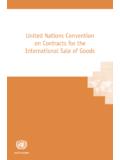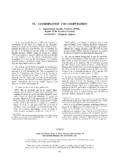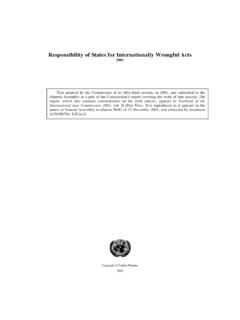Transcription of UNCITRAL Model Law on Electronic Commerce Guide to ...
1 UNITED NATIONSP rinted in January 1999 4, January 2000 2, December 2001 2,000 UNCITRALM odel Law onElectronic CommerceGuide to Enactmentwith1996with additional article 5as adopted in 1998bisUnited Nations publicationSales No.: 92-1-133607-4 UNCITRALM odel Law onElectronic CommercewithGuide to Enactment1996with additional article 5 bis as adopted in 1998 UNITED NATIONS PUBLICATIONS ales No. 92-1-133607-4 UNCITRALM odel Law onElectronic CommercewithGuide to Enactment1996with additional article 5 bis as adopted in 1998 New York, 1999 UNITED NATIONS vCONTENTSPageGENERAL ASSEMBLY RESOLUTION 51/162 OF 16 DECEMBER 1996 .. 1 UNCITRAL Model LAW ON Electronic Commerce .. 3 Part one. Electronic Commerce in general .. 3 Chapter I. General provisions .. 3 Article of application .. 3 Article .. 4 Article .. 4 Article by agreement .. 4 Chapter II. Application of legal requirements to data messages.
2 5 Article recognition of data messages .. 5 Article 5 by reference .. 5 Article .. 5 Article .. 5 Article .. 6 Article 9. Admissibility and evidential weight of data messages .. 7 Article 10. Retention of data messages .. 7 Chapter III. Communication of data messages .. 8 Article and validity of contracts .. 8 Article by parties of data messages .. 8 Article 13. Attribution of data messages .. 8 Article 14. Acknowledgement of receipt .. 9 Article and place of dispatch and receipt of data messages . 11 Part Commerce in specific areas .. 12 Chapter I. Carriage of goods .. 12 Article related to contracts of carriage of goods .. 12 Article 17. Transport documents .. 12viParagraphs PageGUIDE TO ENACTMENT OF THE UNCITRAL Model LAWON Electronic Commerce .. 1-15015 Purpose of this Guide .. 115I. Introduction to the Model Law.
3 Framework law to be supplemented by technicalregulations .. functional-equivalent approach .. rules and mandatory law .. from UNCITRAL secretariat .. 22-2322II. Article-by-article remarks .. 24-12223 Part one. Electronic Commerce in general .. 24-10723 Chapter provisions .. 24-4523 Article of application .. 24-2923 Article 2. Definitions .. 30-4026 Article .. 41-4329 Article by agreement .. 44-4530 Chapter of legal requirements to data messages . 46-7531 Article recognition of data messages .. 4631 Article 5 by reference .. 46-1-46-732 Article .. 47-5235 Article .. 53-6137 Article .. 62-6941 Article and evidential weight of dataArticle .. 70-7144 Article of data messages .. 72-7544 Chapter of data messages .. 76-10746 Article and validity of contracts .. 76-8046 Article by parties of data messages.
4 81-8248 Article of data messages .. 83-9249 Article 14. Acknowledgement of receipt .. 93-9951 Article and place of dispatch and receipt of dataArticle .. 100-10754viiParagraphs PagePart Commerce in specific areas .. 108-12258 Chapter I. Carriage of goods .. 110-12258 Article 16. Actions related to contracts of carriage of goods111-11259 Article 17. Transport documents .. 113-12259 III. History and background of the Model Law .. 123-150631 Resolution adopted by the General Assembly[on the report of the Sixth Committee (A/51/628)]51/162 Model Law on Electronic Commerce adopted bythe United Nations Commissionon International Trade LawThe General Assembly,Recalling its resolution 2205 (XXI) of 17 December 1966, by which itcreated the United Nations Commission on International TradeLaw, with a mandate to further the progressive harmonization andunification of the law of international trade and in that respect to bearin mind the interests of all peoples, in particular those of developingcountries, in the extensive development of international trade,Noting that an increasing number of transactions in internationaltrade are carried out by means of Electronic data interchange and othermeans of communication, commonly referred to as Electronic com-merce , which involve the use of alternatives to paper-based methodsof communication and storage of information,Recalling the recommendation on the legal value of computerrecords adopted by the Commission at its eighteenth session, in 1985,1and paragraph 5(b)
5 Of General Assembly resolution 40/71 of 11 Decem-ber 1985, in which the Assembly called upon Governments and interna-tional organizations to take action, where appropriate, in conformitywith the recommendation of the Commission,1 so as to ensure legalsecurity in the context of the widest possible use of automated dataprocessing in international trade,1 See Official Records of the General Assembly, Fortieth Session, Supplement No. 17(A/40/17), chap. VI, sect. that the establishment of a Model law facilitating theuse of Electronic Commerce that is acceptable to States with differentlegal, social and economic systems, could contribute significantly tothe development of harmonious international economic relations,Noting that the Model Law on Electronic Commerce was adoptedby the Commission at its twenty-ninth session after consideration ofthe observations of Governments and interested organizations,Believing that the adoption of the Model Law on Electronic Com-merce by the Commission will assist all States significantly in enhancingtheir legislation governing the use of alternatives to paper-based meth-ods of communication and storage of information and in formulatingsuch legislation where none currently exists.
6 Its appreciation to the United Nations Commissionon International Trade Law for completing and adopting the Model Lawon Electronic Commerce contained in the annex to the present resolu-tion and for preparing the Guide to Enactment of the Model Law; that all States give favourable consideration tothe Model Law when they enact or revise their laws, in view of theneed for uniformity of the law applicable to alternatives to paper-basedmethods of communication and storage of information; also that all efforts be made to ensure that theModel Law, together with the Guide , become generally known plenary meeting16 December 19963 UNCITRAL Model Law onElectronic Commerce [Original: Arabic, Chinese, English, French, Russian, Spanish]Part one. Electronic Commerce in generalCHAPTER I. GENERAL PROVISIONSA rticle 1. Sphere of application*This Law** applies to any kind of information in the form of a datamessage used in the context** of commercial** activities.
7 *The Commission suggests the following text for States that might wish to limit theapplicability of this Law to international data messages: This Law applies to a data message as defined in paragraph (1) of article 2 where thedata message relates to international Commerce . **This Law does not override any rule of law intended for the protection of consumers.**The Commission suggests the following text for States that might wish to extendthe applicability of this Law: This Law applies to any kind of information in the form of a data message, except inthe following situations: [..]. **The term commercial should be given a wide interpretation so as to covermatters arising from all relationships of a commercial nature, whether contractual or of a commercial nature include, but are not limited to, the following transac-tions: any trade transaction for the supply or exchange of goods or services; distributionagreement; commercial representation or agency; factoring; leasing; construction of works;consulting; engineering; licensing; investment; financing; banking; insurance; exploitationagreement or concession; joint venture and other forms of industrial or business cooperation;carriage of goods or passengers by air, sea, rail or 2.
8 DefinitionsFor the purposes of this Law:(a) Data message means information generated, sent, receivedor stored by Electronic , optical or similar means including, but notlimited to, Electronic data interchange (EDI), Electronic mail, telegram,telex or telecopy;(b) Electronic data interchange (EDI) means the electronictransfer from computer to computer of information using an agreedstandard to structure the information;(c) Originator of a data message means a person by whom, oron whose behalf, the data message purports to have been sent orgenerated prior to storage, if any, but it does not include a personacting as an intermediary with respect to that data message;(d) Addressee of a data message means a person who isintended by the originator to receive the data message, but does notinclude a person acting as an intermediary with respect to that datamessage;(e) Intermediary , with respect to a particular data message,means a person who, on behalf of another person, sends, receives orstores that data message or provides other services with respect to thatdata message;(f) Information system means a system for generating, send-ing, receiving, storing or otherwise processing data 3.
9 Interpretation(1) In the interpretation of this Law, regard is to be had to its inter-national origin and to the need to promote uniformity in its applicationand the observance of good faith.(2) Questions concerning matters governed by this Law which arenot expressly settled in it are to be settled in conformity with thegeneral principles on which this Law is 4. Variation by agreement(1) As between parties involved in generating, sending, receiv-ing, storing or otherwise processing data messages, and except as5otherwise provided, the provisions of chapter III may be varied byagreement.(2) Paragraph (1) does not affect any right that may exist to modifyby agreement any rule of law referred to in chapter II. APPLICATION OF LEGAL REQUIREMENTS TO DATA MESSAGESA rticle 5. Legal recognition of data messagesInformation shall not be denied legal effect, validity or enforce-ability solely on the grounds that it is in the form of a data 5 bis.
10 Incorporation by reference(as adopted by the Commission at its thirty-first session, in June 1998)Information shall not be denied legal effect, validity or enforce-ability solely on the grounds that it is not contained in the data mes-sage purporting to give rise to such legal effect, but is merely referredto in that data 6. Writing(1) Where the law requires information to be in writing, that require-ment is met by a data message if the information contained therein isaccessible so as to be usable for subsequent reference.(2) Paragraph (1) applies whether the requirement therein is in theform of an obligation or whether the law simply provides conse-quences for the information not being in writing.(3) The provisions of this article do not apply to the following: [..].Article 7. Signature(1) Where the law requires a signature of a person, that requirementis met in relation to a data message if:6(a)a method is used to identify that person and to indicate thatperson s approval of the information contained in the data message; and(b)that method is as reliable as was appropriate for the purposefor which the data message was generated or communicated, in thelight of all the circumstances, including any relevant agreement.









